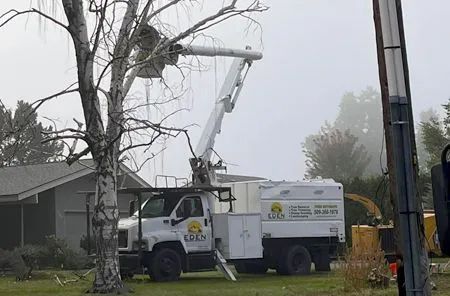Blog
4 Indications that a Tree Has Become More Likely to Topple Over During a Storm
Eden Landscaping & Tree Service • November 9, 2025

Storms can bring powerful winds, heavy rain, and saturated soil—conditions that can quickly turn a weakened tree into a serious hazard. While healthy trees can typically withstand some rough weather, those that are damaged, diseased, or structurally compromised are far more likely to fall. A tree coming down during a storm can cause significant property damage and pose serious safety risks. Identifying warning signs early allows you to take action before bad weather hits. At Eden Landscaping & Tree Service, we provide expert hazardous tree removal in the greater Kennewick area. Here are four signs that a tree on your property has become more likely to crash down during a storm.
Leaning More Than Before
A tree that has recently begun leaning is often a red flag. While some trees naturally grow at an angle, a sudden or increasing lean can indicate that the root system has become unstable. This instability might be due to soil erosion, decay, or damage from strong winds in previous storms. If the lean appears to worsen over time or you notice soil cracking or lifting on one side of the base, the tree may be at serious risk of falling when the next storm arrives.
Cracked Trunk
A tree’s trunk is its main support structure, so any significant cracks, splits, or wounds should be taken seriously. Damage to the trunk weakens the tree’s overall stability, especially under the stress of high winds. These cracks often occur due to previous storm damage, improper pruning, or internal decay. In some cases, a split trunk can indicate that the tree is already partially failing.
Root Problems/Soil Movement
Roots are responsible for anchoring the tree firmly into the ground. If they become damaged, decayed, or exposed, the entire tree’s structure becomes compromised. Fungal growth at the base of the tree often points to root rot, while loose or heaving soil can suggest movement in the root zone. Because root issues often develop underground, visible symptoms at the surface may indicate that significant decay has already taken hold.
Visible Decay/Hollow Areas
Decay inside the trunk or large limbs significantly reduces a tree’s strength. Cavities and soft wood can indicate internal rot. Even if a tree still appears green and leafy, it could be structurally unstable inside. During a storm, this hidden weakness can lead to sudden failure.
Tree Removal in Kennewick, WA
For expert
tree removal in Kennewick and the surrounding area, contact Eden Landscaping & Tree Service at
509.289.5009. Feel free to give us a call to arrange a tree services estimate in the Tri-Cities area!



